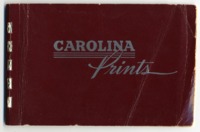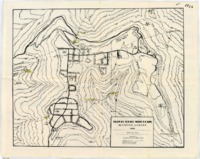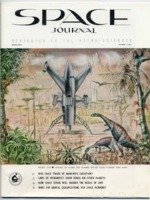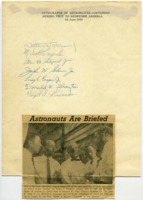
Browse Items (451 total)
Sort by:
-
Letter from Col. John C. Nickerson at Redstone Arsenal in Huntsville, Alabama, to Gen. James A. Pickering in Atlanta, Georgia.
In this letter, Nickerson thanks Gen. Pickering for his support and explains why he believes the Army is the best service branch to develop ballistic missiles. He also discusses the need for missiles in case of war with the Soviet Union. Nickerson was a staff officer at the Army Ballistic Missile Agency at Redstone Arsenal assigned to work on the Jupiter, the United States' first mid-range ballistic missile. He was arrested and court martialed for espionage in 1957 after releasing sensitive documents about the United States missile program to the press. At the time, Secretary of Defense Charles E. Wilson granted the Air Force sole authority to develop intermediate range ballistic missile systems. Nickerson disagreed with this policy, and in response, leaked documents that demonstrated the superiority of Army missiles compared to those developed by the Air Force. He eventually pled guilty to lesser charges and was suspended from the Army for one year and was fined $1,500. Dr. Wernher von Braun was among those who testified on Nickerson's behalf. -
Frances C. Roberts at commencement at the University of Alabama.
This photo was taken at the time of Roberts' doctoral graduation from the University of Alabama in Tuscaloosa, Alabama. She was the first woman to receive a Ph.D. in history from the University of Alabama. On either side of her are Howard C. Elliot, Jr., Ph.D. in biochemistry, and Elmer Dean Calloway, Ph.D. in chemistry. -
Letter from Sen. Lister Hill, Sen. John Sparkman, and Rep. Bob Jones to Huntsville radio stations.
Addressed to stations WBHP and WFUN, the letter announces that the U. S. Senate passed "legislation authorizing construction work for Redstone Arsenal totaling $4,250,000." The letter also mentions building rocket test stations and a flight test range. -
Photo album of downtown Huntsville from the city's sesquicentennial celebration.
The album includes photos of the Confederate monument and banners and decorations on the street. -
Photo album of downtown Huntsville from the city's sesquicentennial celebration.
The photos show scenes from the sesquicentennial festivities in and around the square, including people dressed in early nineteenth century attire, storefronts, and street decorations. -
Topographical map of Monte Sano.
This map was drawn by William W. Varnedoe, Jr. and published by the Monte Sano Civic Association. It shows Monte Sano's neighborhoods, the state park, and the mountain's natural features, including springs and caves. The map also notes changes in elevation. -
Space Journal, vol. 1, no. 1., Summer 1957.
This issue of Space Journal includes articles written by Fred L. Whipple, Hermann Oberth, and Ernst Stuhlinger, as well as a foreword by Wernher von Braun. The issue also includes drawings for an observatory to be built at the top of Monte Sano Mountain in Huntsville, Alabama. Produced by the Rocket City Astronomical Association (now known as the Von Braun Astronomical Society), Space Journal was published in Huntsville from 1957 to 1959. This digitized copy was generously provided by Jeff Bennett at the Von Braun Astronomical Society (VBAS). -
Coal barge on the Tennessee River.
A note on the reverse of the photograph reads, "Ton of coal passing Decatur on the Tennessee River." -
Parts of a V-2 rocket on display on the west side of Courthouse Square in Huntsville, Alabama.
The tank on the left is labeled "V-2 Alcohol Container," while the tank on the right is labeled "V-2 Liquid Oxygen Container." On the far right of the photo is the "V-2 Propulsion Unit." In the background are various businesses, including P. M. Woodfin Cotton, Anderson Clayton & Co. Cotton Buyers, and First National Bank. -
Certificate of Naturalization for Gertrud Meta Schulze.
Gertrud Schulze was naturalized on the same day as her husband, William August Schulze. The back of the certificate notes that her name was legally changed at the same time she was naturalized. -
Naturalization ceremony program.
Held at the Huntsville High School auditorium, the ceremony naturalized many of the German engineers who were transferred to Huntsville in 1950. -
Department of the Army Permanent Pass.
This pass was issued by the Office of the Chief of Ordnance, Research and Development Division Suboffice (Rocket), at Fort Bliss, Texas. -
"Notice to Petitioner."
This card was sent from the U. S. Department of Justice Immigration and Naturalization Service in Atlanta, Georgia to William August Schulze. The card serves as notification of his naturalization hearing at the Post Office Building in Birmingham, Alabama, on November 11, 1954. Typed instructions at the bottom of the card read, "BRING YOUR ALIEN REGISTRATION CARD WITH YOU." Schulze was later naturalized in Huntsville on April 14, 1955. -
Hermes guided missile on display.
The sign in front of the missile reads, "Hermes Guided Missile, U.S. Army Ordnance, Redstone Arsenal, Huntsville, Ala." -
Juno II launch.
Juno II was developed by the Army Ballistic Missile Agency in Huntsville, Alabama. -
Space Journal, vol. 1, no. 4, Fall 1958.
This issue discusses at length the competition in science, technology, and engineering between the United States and the Soviet Union, including comparisons of developments in missiles, satellites, and educational systems. This issue also includes plans for a village on the Moon. Includes the subscription card inserted in the center of the issue. -
Space Journal, vol. 1, no. 5, March-May 1959.
This issue includes a statement announcing Space Journal's termination of all connections with the U.S. military and with the Rocket City Astronomical Association. At the time, commander of the Army Ballistic Missile Agency (ABMA) at Redstone Arsenal Gen. John B. Medaris was concerned that the publishers and writers, all in the employ of ABMA, were using their government positions for personal gain through the magazine. Topics covered in the issue include the dangers and feasibility of space travel, designing buildings for life on the Moon, and the existence of life elsewhere in the universe. -
Space Journal, vol. 2, no. 2, December 1959.
In this issue, articles focus heavily on the exploration of space and the particulars of human activities in space, including "the space man's food," research on how weightlessness affects the human body, and the lack of laws governing space. Also included is a profile of Roy Marquardt, "the ramjet man" and founder of Marquardt Aircraft Company. This is the final published issue of Space Journal. -
News clippings announcing new citizenship for a group of German teenagers living in Huntsville, Alabama.
The members of the group were all children of German engineers who were brought to the United States under Operation Paperclip. The clippings include photos of the group with their new immigration registration cards. -
Wernher von Braun, William A. Mrazek, and M.E. Huston with a rocket nose cone recovered from space.
The photo is signed by Von Braun, Mrazek, and Huston. -
Autographs of the Mercury Seven astronauts.
The group gave out autographs during their visit to Redstone Arsenal in 1959. A news clipping with a photograph of five of the seven astronauts in Huntsville is attached. -
"Haskins Makes Quick Change from Civilian Ph.D. to Pfc."
Clipping from the Redstone Rocket, March 2, 1954. The article highlights Haskins' background as a physicist and his role in the 9330 Technical Service Unit. -
"Rocket City Astronomical Association."
The pamphlet includes a reprint of an article from RCAA publication Space Journal, a history of the organization with photos, and membership information. -
Excerpt from the journal of Charles A. Lundquist.
The entry describes a meeting during which Lundquist, Wernher von Braun, Ernst Stuhlinger, and John O'Keefe discuss the possibility of a Russian satellite launch and the U.S. Navy's Project Vanguard. -
Map of "Village on the Moon for Scientists and Visitors," from Space Journal, vol. 1, no. 4, Fall 1958.
Japanese architect and engineer Hiroshi Kumagai drew this map of a moon base to accompany his article "A Proposal for a Village on the Moon." -
Early UAH class held at West Huntsville High School.
UAH held classes at West Huntsville High School in the 1950s before the university had its own campus. -
"Patrick AFB - our [illegible] in Cocoa -- Hotel Tradewinds Club, June 1959."
Konrad, Klaus, and Ingeborg Dannenberg go down to vacation in Cape Canaveral, Florida. They are shown visiting the air and space museum (now called the Kennedy Space Center Visitor Center), stopping at Mac's Grove fruit stand, and leaving the Tradewinds Club. June 1959. -
"'Tradewinds' - pool, June 1959."
Konrad, Klaus, and Ingeborg Dannenberg enjoy the pool at the Tradewinds Club where they're staying outside of Cape Canaveral, Florida. They're shown swimming, lounging in the sun, and using the diving board. June 1959. -
"Melbourne Beach, June 1959."
Konrad, Klaus, and Ingeborg Dannenberg visit Melbourne beach near Melbourne, Florida. All members of the family are shown playing in the surf as well as hunting for seashells. June 1959. -
"Florida June 1959 - New York July 16th 1959 MS Berlin."
First half of film shows Konrad, Klaus, and Ingeborg Dannenberg enjoying lunch by the pool at the Tradewinds Club outside of Cape Canaveral, Florida. The second half shows Ingeborg and Klaus departing by ship. June 1959.




































